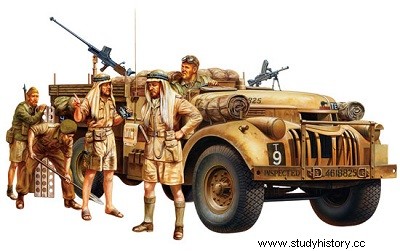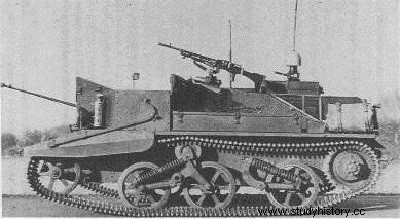
The Boys anti-tank rifle (in English Rifle, Anti-Tank, .55 in, Boys), sometimes incorrectly called "Boyes", was a British anti-tank rifle. Three successive versions of the weapon existed, the first model Mark I (Mk I) with a circular muzzle brake and a monopod in T, the Mark II (Mk II), square muzzle brake and bipod in V, and the third model intended for airborne troops with a shortened barrel and no muzzle brake. There were also different types of ammunition, the last used having better penetration performance.
Design and development
The British Army was looking for an anti-tank weapon to equip its infantry. After briefly looking for an answer in the Oerlikon 20 mm cannon, then the Elswick 0.8 inch machine gun, the development of a high-velocity anti-tank rifle was launched.
The creator of this firearm is Captain H. C. Boys, a member of the British Small Arms Committee and designer at the Royal Small Arms Factory at Enfield Lock. The rifle was first named Stanchion (stanchion), but it took the name of its creator in his honor, the captain having died a few days before the rifle was declared fit for service on November 24, 1937. /P>
This repeating rifle, fed by a magazine holding five rounds, was large and heavy, equipped with a bipod at the front and an offset grip under the padded stock. In order to combat the strong recoil of the weapon, linked to its 0.55 inch (13.9 mm) ammunition, the barrel was mounted on a rail, a shock absorber was fixed on the bipod and a muzzle brake supplemented these devices. But despite all this, the recoil of the weapon, as well as the sound of the explosion, was terrifying, causing frequent tears in the neck muscles and bruises on the shoulders. Therefore, the weapon was practically never used freely, except in an emergency, but always put on a support.
The Boys had been designed with many parts, fastened by many small fine screws in mild steel engravings, arranged very close to each other in the body of the weapon. Maintaining and repairing these weapons proved to be hell for the British General Staff repair crews.
Versions
Boys rifle, Mark I. Equipped with a monopod, circular muzzle brake.
Boys rifle, Mark II. Equipped with a bipod, square muzzle brake.
Boys rifle Airborne. Approved 4 July 1942, shortened barrel for airborne troops. Equipped with a cushion filled with feathers, and aluminum parts to lighten it.
Ammunition
Two types of cartridges were mainly used during the Second World War, the W Mark 1 (armor-piercing projectile of 60 g at 747 m/s) and the W Mark 2 (armor-piercing projectile of 47.6 g at 884 m/s). /P>
The W Mark 1 ammunition could penetrate approximately 16mm of armor at 100 yards (91 meters), the thickness of the frontal armor of a half-track or armored car, or that of the sides or rear of a light tank.
Later in the conflict, a more effective ammunition was developed, the W Mark 2. The cartridge in question here was an adaptation of Browning's .50 caliber, on the case of which was added a bead at the level of the base. The tungsten projectile weighed 47.6 grams and traveled at 884 m/s. The W Mk 2 could penetrate up to 19 mm of armor at 100 yards (91 meters), the plate being inclined by 20°, the effectiveness increasing to 21.5 mm for a perpendicular shot. Its effective range against unarmored targets, such as infantry, was much greater.
In service
The Boys rifle was used during the early stages of World War II against German armour, light tanks and half-tracks. The British also sent many of their rifles to Finland between 1939 and 1940, during the conflict between it and the Soviet Union. The weapon was appreciated by the Finns, because it was very effective against the T-26 tanks of the Red Army.
Although useful against early German, Italian or Soviet tanks, as the case may be, in the Norwegian campaign, the Battle of France, the North African campaign or the Winter War, the gradual increase in armor combat vehicles during World War II rendered the rifle progressively ineffective. In addition, the lack of maneuverability of the weapon (see above, use almost always in a fixed position) made its use incompatible with the opposing strategy of blitzkrieg, where armored vehicles suddenly appeared.
The last version of 1942, adapted for airborne troops, was used in Tunisia, and proved to be totally ineffective due to the reduced speed of the projectile at the exit of its shortened barrel. In the European theater, he was soon replaced in the anti-tank infantry units by the PIAT during a reorganization of these on April 30, 1943. .
It was also used against bunkers, machine gun nests, or against unarmoured vehicles, but it was quickly replaced in British and Commonwealth troops by the Browning .50 caliber machine gun. Using armour-piercing (AP) ammunition, armour-piercing incendiary (API) ammunition, or armour-piercing incendiary tracer (APIT) ammunition, the .50 caliber was capable of comparable penetration, with even worse effects in the case of incendiary rounds used against lightly armored vehicles. In this case, it could also serve as an effective anti-aircraft weapon. Even the British SAS or the famous Long Range Desert Group, which used a lot of material taken from the enemy or recovered from planes or other to mount them on their jeeps and reconnaissance vehicles, quickly got rid of their Boys in favor of .50 caliber machine guns or 20 mm Breda Model 35 Italian cannons.

However, in the Pacific theater, the Boys rifle remained in service longer, still effective against Japanese light armor like the Type 95, for example in British Malaya until 1942, when the 14th Company of the 1st Punjab Regiment destroyed two Japanese light tanks on a road. With the British and other Commonwealth troops lacking a long-range anti-tank rocket launcher in the area, such as a bazooka or panzerschreck, the Boys remained in inventory in this area of operation
Mounted use

The Boys rifle was sometimes mounted on light vehicles, such as the Bren Carrier or the Standard Beaverette armored car.
List of users
German Reich - Rifles captured after re-embarkation from Dunkirk, France and Norway were used by German forces, as Panzerbüchse Boyes (sic).
Australia - Nicknamed 'Charlie the bastard", due to its recoil.
Canada
Republic of China (Taiwan) - Some examples were rechambered to accommodate .50 BMG ammunition, to be used as a sniper rifle.
United States - Used by Marines, and nicknamed "Elephant Gun", due to its weight and recoil.
Finland - Named in inventory "14 mm pst kiv/37", used during the Winter War and the Continuation War.
Free France - Used by the 1st Free French Division during the Battle of Bir Hakeim.
Ireland
New Zealand
United Kingdom
Boys anti-tank rifle
Country United Kingdom
Type Anti-tank rifle
Ammunition Kynoch &RG .55 Boys (13.9 x 99mm B)
Manufacturer Royal Small Arms Factory, Enfield Lock
Term of service 1937-1943
Production Approximately 62,000
Weights and dimensions
Mass (unladen) 16 33 kg (36 lbs)
Length(s) 1613 mm
Barrel length 914 mm or 762 mm for airborne troops
Technical features
Architecture H. C. Boys
Mode of action with lock
Practical range Penetration of 16-19 mm armor at 90° at 91 m 1
Rate of fire 10 rounds/min
Initial velocity 747 (then 884) m/s2
Capacity 5 rounds, top loaded
Variants Mk I, Mk II, Airborne (version for airborne troops)
